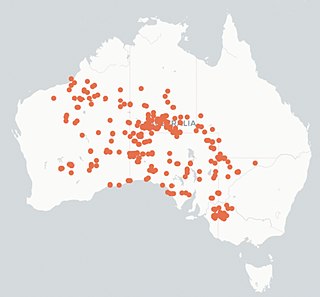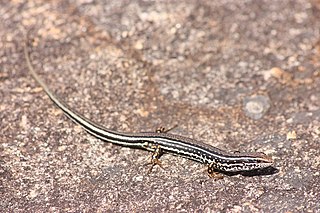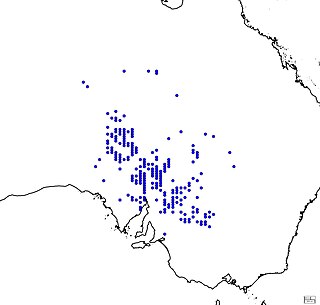The Lancelin Island skink, also known commonly as the Lancelin south-west ctenotus and the south-west ctenotus, is a species of skink, a lizard in the subfamily Sphenomorphinae of the family Scincidae. The species is endemic to Australia.

Morethia boulengeri is a species of lizard in the family Scincidae. The species is endemic to Australia.

The northern spiny-tailed gecko is a species of lizard in the family Diplodactylidae. The species is endemic to Australia.
Ctenotus zebrilla, also known commonly as the Southern Cape York fine-snout ctenotus, is a species of skink, a lizard in the family Scincidae. The species is endemic to Australia.
Ctenotus atlas, the southern Mallee ctenotus, is a medium sized lizard in the family scincidae (skink) found in the central and southern interior regions of South Australia and Western Australia; the Mallee regions of NSW and Victoria, in Australia.

Ctenotus brooksi, also known commonly as Brooks' wedge-snouted ctenotus, the wedgesnout ctenotus, and the sandhill ctenotus, is a species of skink, a lizard in the family Scincidae. The species is endemic to Australia and found in semi-arid regions.

Ctenotus burbidgei, also known commonly as the plain-backed Kimberley ctenotus, is a species of skink, a lizard in the family Scincidae. The species is native to Western Australia.
The brown-backed ctenotus, also known commonly as Cogger's ctenotus, is a species of skink, a lizard in the subfamily Sphenomorphinae of the family Scincidae. The species is endemic to the Northern Territory in Australia.
Ctenotus colletti, also known commonly as the buff-tailed finesnout ctenotus, Collett's ctenotus, and Collett's skink, is a species of lizard in the family Scincidae. The species is endemic to Australia.

Ctenotus essingtonii, also known commonly as Essington's ctenotus and the lowlands plain-backed ctenotus, is a species of skink, a lizard in the family Scincidae. The species is endemic to the Northern Territory in Australia.
Ctenotus hanloni, also known commonly as Hanlon's ctenotus and the nimble ctenotus, is a species of skink, a lizard in the family Scincidae. The species is endemic to Australia.
Ctenotus ingrami, also known commonly as Ingram's ctenotus and the unspotted yellow-sided ctenotus, is a species of skink, a lizard in the family Scincidae. The species is native to Queensland and New South Wales in Australia.
Ctenotus joanae, also known commonly as the blacksoil ctenotus and the black-soil ctenotus, is a species of lizard in the subfamily Sphenomorphinae of the family Scincidae (skinks). The species is endemic to Australia.

Ctenotus labillardieri, also known commonly as the common south-west ctenotus, Labillardier's ctenotus, and the red-legged ctenotus, is a species of skink, a lizard in the family Scincidae. The species is endemic to the Australian state of Western Australia.

Ctenotus leae, also known commonly as the Centralian coppertail, Lea's ctenotus, and the orange-tailed finesnout skink, is a species of lizard in the subfamily Sphenomorphinae of the family Scincidae. The species is endemic to Australia.

Ctenotus leonhardii, known by the common names Leonhardi's ctenotus, Leonhardi's skink, and the common desert ctenotus, is a species of lizard in the subfamily Sphenomorphinae of the family Scincidae. The species is found in a range of arid and semi-arid regions throughout mainland Australia. Named after German anthropologist Moritz von Leonhardi in 1919, it belongs to the genus Ctenotus, one of the largest genera of lizards in Australia.

Ctenotus olympicus, the olympic ctenotus, spotted ctenotus or saltbush ctenotus, is a species of skink endemic to the arid shrublands of central and southern Australia.

Ctenotus regius, the pale-rumped ctenotus or regal striped skink, is a medium-sized species of skink with an arid distribution restricted to the Australian Mainland, which belongs to the largest group of reptiles in Australia, Ctentotus.
Ctenotus stuarti, also known commonly as the Point Stuart ctenotus or Stuart's ctenotus, is a species of skink, a lizard in the family Scincidae. The species is endemic to Australia.

Ctenotus helenae, also known commonly as the clay-soil ctenotus, is a species of skink, a lizard in the family Scincidae. The species is endemic to Australia.













